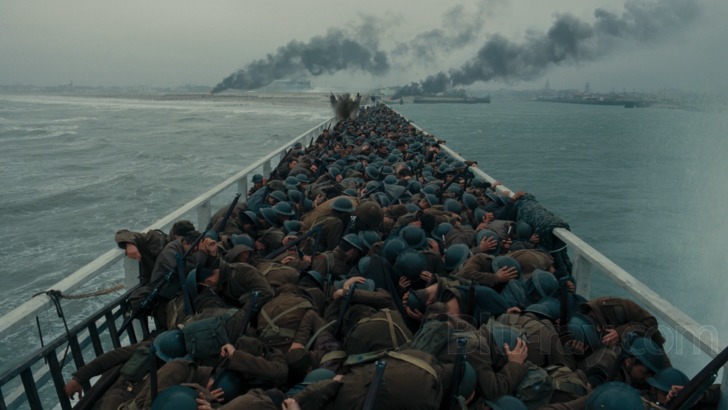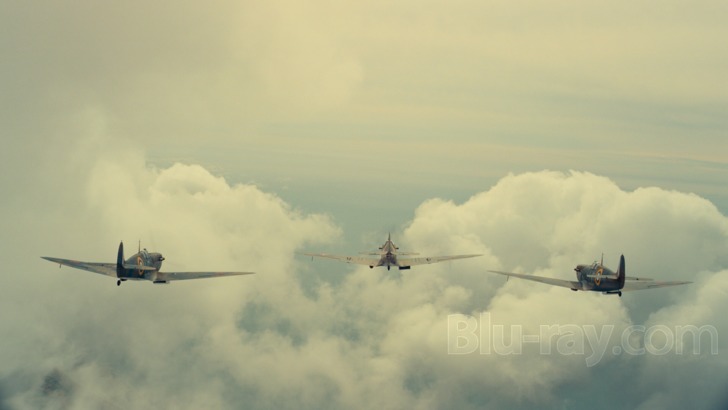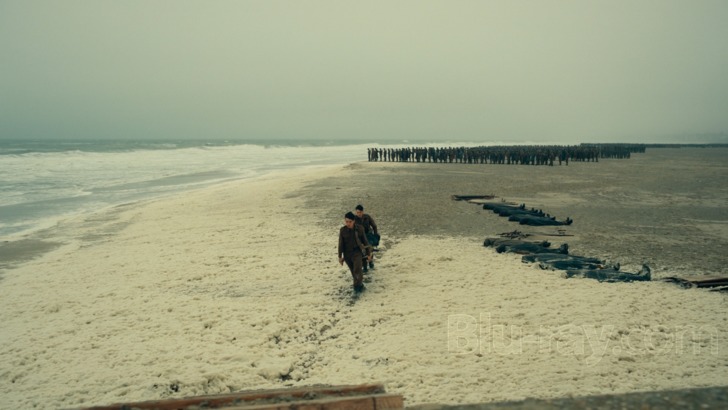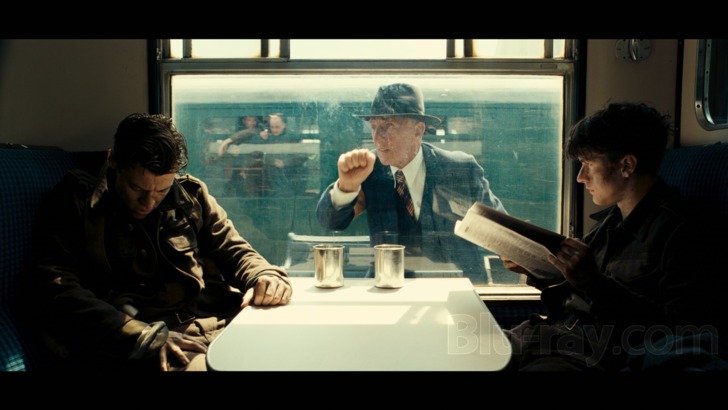Dunkirk Blu-ray Movie
HomeDunkirk Blu-ray Movie 
Blu-ray + DVD + UV Digital CopyWarner Bros. | 2017 | 107 min | Rated PG-13 | Dec 19, 2017

Movie rating
7.5 | / 10 |
Blu-ray rating
| Users | 3.9 | |
| Reviewer | 4.0 | |
| Overall | 3.9 |
Overview
Dunkirk (2017)
Allied soldiers from Belgium, Britain and France are surrounded by the German army and evacuated during a fierce battle in World War II.
Starring: Fionn Whitehead, Tom Glynn-Carney, Jack Lowden, Harry Styles, Aneurin BarnardDirector: Christopher Nolan
| Action | Uncertain |
| Drama | Uncertain |
| Thriller | Uncertain |
| History | Uncertain |
| War | Uncertain |
Specifications
Video
Video codec: MPEG-4 AVC
Video resolution: 1080p
Aspect ratio: 1.78:1, 2.20:1
Original aspect ratio: 2.20:1
Audio
English: DTS-HD Master Audio 5.1 (48kHz, 16-bit)
French (Canada): Dolby Digital 5.1
Spanish: Dolby Digital 5.1 (448 kbps)
Portuguese: Dolby Digital 5.1
English: Dolby Digital 5.1 (448 kbps)
English DD=narrative descriptive
Subtitles
English SDH, French, German SDH, Portuguese, Spanish
Discs
Blu-ray Disc
Three-disc set (2 BDs, 1 DVD)
UV digital copy
DVD copy
Packaging
Slipcover in original pressing
Playback
Region free
Review
Rating summary
| Movie | 3.5 | |
| Video | 5.0 | |
| Audio | 5.0 | |
| Extras | 4.0 | |
| Overall | 4.0 |
Dunkirk Blu-ray Movie Review
World War II—What a Ride!
Reviewed by Michael Reuben December 17, 2017Dunkirk arrives on Blu-ray and UHD amidst a full-court awards press by Warner Brothers and director
Christopher Nolan, who are hoping to add a few statuettes to the film's impressive box office.
The film is also the vanguard of a massive technical effort to present seven of Nolan's films on
UHD, a format of which the director is such an enthusiastic convert that he has personally
overseen the 4K preparation of all seven films. It's an interesting turn toward digital presentation
for a filmmaker whose commitment to celluloid is legendary and whose movies routinely sport a
credit indicating that they have been "Shot and Finished on Film". With even diehards like Steven Spielberg choosing the digital
intermediate route for
post-production, Nolan has become the most eminent holdout to remain committed to achieving
his artistic vision by photochemical means.
Nolan is also rare among modern-day directors in preferring live action "in camera" effects over
digital trickery, a predilection that is repeatedly stressed throughout the Blu-ray's extensive
special features. As a triumph of filmmaking technique and innovation, Dunkirk stands favorable
comparison with any of classical Hollywood's epic pre-digital achievements. The question is whether the
film effectively grounds its vistas in an emotional immediacy that can breathe life into
technical accomplishments which, by themselves, are impressive but soulless. On that score, at
least for this viewer, Dunkirk does not succeed.
As anyone reading Blu-ray.com probably already knows, Dunkirk was shot with a combination of
IMAX 65 and Panavision 65 cameras, and it was released to theaters in a variety of formats,
including 70mm, IMAX and IMAX 70mm. It's an ideal source for 4K presentation in the home,
and Nolan reportedly regards Dunkirk's UHD
as its definitive representation on video. By
comparison, the standard Blu-ray, which pushes the 1080p format to its limits, is something of a
poor stepchild. It's been prepared with exquisite care under Nolan's supervision, and it's a
superb presentation, but there's only so much resolution and refinement that Blu-ray can offer,
especially with a large-negative source such as Dunkirk.

After I saw Dunkirk theatrically—in 70mm, seated dead center in front of a three-story-high IMAX screen—I described it to friends and family as the opening sequence of Saving Private Ryan extended to feature length. Having now rewatched Nolan's passion project on Blu-ray and UHD, I realize that my earlier description was inaccurate. Like Steven Spielberg in Ryan, Nolan has skillfully deployed vast cinematic resources to plunge the viewer into a maelstrom inspired by a historic World War II engagement. But Spielberg's effort remained anchored in a form of traditional storytelling that has all but disappeared in Dunkirk. Spielberg presented the D-Day invasion as experienced from the viewpoint of one Army officer, and he cannily cast Tom Hanks in the role, relying on one of film's most relatable everymen to establish an instant connection with the audience. After surviving the bloody battle, Hanks's Army captain is charged with an unusual mission, on which he is accompanied by a squad of men whose histories and characters we get to know intimately. Following the shock of its opening, Ryan settles into the familiar narrative pattern of a journey, punctuated by diverse encounters along the way and deepened by our increasing familiarity with the men and our growing attachment to each of them. The war matters to us because it matters to them.
Nolan has dispensed with all such narrative techniques. His characters are blanks, with many played by actors who are largely unknown. Throughout the film they remain almost entirely devoid of personal history or characteristics. The director moves them around the screen like chess pieces in a game that only he—and history—can see in its totality. (Yes, I realize the cast includes familiar faces like Kenneth Branagh and Tom Hardy, but bear with me.) In Nolan's rendition of this crucial moment in both the war and Britain's survival as a nation, individuals no longer matter, and neither do the leaders calling the shots from across the channel in London. (If you want to see what was happening at home, watch Darkest Hour.) What matters is the chaos, and Nolan aspires not just to re-create the chaos but also to subject viewers to an experience replicating the fear and uncertainty of the characters—but not because we are pulled into their world to feel what they do. In Dunkirk, it's not the events depicted on screen that shake us, but the dizzying sights and punishing sounds constructed for our entertainment. For all of Nolan's declared intent to honor the British soldiers and their civilian rescuers, he's recast the Dunkirk evacuation as a multiplex thrill ride that ends up feeling as artificial and self-referential as any of his Dark Knight movies or puzzle creations like Memento and The Prestige. This isn't the Dunkirk of history; it's Nolan's commemorative Tilt-A-Whirl.
The artifice begins with the film's three story lines, each of which runs at a different speed in a separate setting. On the beaches in France where 350,000 British troops have been cornered by the Nazi onslaught, the camera depicts the merciless bombing and strafing from German planes and the desperate (and futile) struggle to evacuate soldiers to the distant British destroyers. A message onscreen tells us that this ordeal lasts a week, although there's little sense of time passing, while Nolan keeps returning to an anonymous soldier identified as "Tommy" in the credits and played by Fionn Whitehead in his first feature film. Meanwhile, in a separate sequence that is said to occupy an hour, a fighter pilot attempts to offer air cover to the evacuation, battling superior forces and his own dwindling fuel supply. His name is Farrier, and he's played by Nolan regular Tom Hardy, but we barely see his face until the film's end, and he's such a generic figure that he could be played by anyone. In the seas below, a small private boat, the Moonstone, is part of the civilian armada mobilized by the British government to cross the Channel and attempt a rescue in waters too shallow for large Navy ships to navigate. Its captain is Mr. Dawson (Mark Rylance), who is accompanied by his son, Peter (Tom Glynn-Carney), and a teenage acquaintance, George (Barry Keoghan), a diffident kid who just wants to be part of the war effort. En route, they rescue a shell-shocked soldier (Cillian Murphy) from a wrecked ship, who panics when he realizes that the Moonstone is returning him to Dunkirk. The sea sequence comes closest to traditional drama, simply because something has to fill the time during the day's length of the voyage.
Nolan orchestrates these sequences with precision, and editor Lee Smith, who has edited nearly all of the director's films, expertly cross-cuts among them, while Hans Zimmer's throbbing score generates a visceral sense of urgency that is accentuated by the ticking clock incorporated into the sound mix. But one is always aware of the artificiality of Nolan's temporal conceit, which demands the viewer's attention as much as—or even more than—the events being portrayed. As the three time periods converge, Dunkirk becomes an intellectual guessing game, challenging you to analyze where each strand will intersect the other and nudging your attention away from the perilous history that the film is working so hard to portray. The film's sights and sounds are effectively unnerving, but they also remain abstract. There's barely any sense of connection between historical events and the viewer.
The one exception to this chilly distance occurs in the seafaring segment, where the Moonstone's voyage effectively individuates several of the characters, notably Mark Rylance's Dawson. Much of the credit is due to Rylance, who is one of the finest actors working today, with an Oscar for Bridge of Spies and a shelf-load of theater awards too numerous to list. In Dawson's distinctive demeanor—simultaneously mournful, resigned, steadfast and determined—Rylance does what no other performer in Dunkirk manages to pull off, effectively willing into existence a specific and memorable character to which the viewer feels a connection, even if one can't say exactly what it is. (The connection becomes more concrete when key facts are revealed late in the film.) The particularity of Rylance's portrayal spreads to that of his son and of young George, whose involvement in the Dunkirk evacuation provides a poignant coda to the film. By contrast to Rylance and his makeshift crew, Cillian Murphy's traumatized survivor is a skeletal outline of a person, who has been inserted into the story to provide conflict. Similar abstraction befalls the naval officer played by Kenneth Branagh in the beach scenes, whose job is provide the bare essentials of exposition about the challenges of rescue. Branagh gives the part his all, and he's a fine enough actor to create the illusion of a full-blooded character for as long as he's on the screen, but his commander remains as generic as Hardy's flyer, and he leaves no impression once the film ends.
Ridley Scott has spoken of film directing as a "performance", and Nolan's performance is certainly the star of Dunkirk. As the director coordinates aerial dogfights, stages perilous sea encounters and choreographs masses of extras on the beach in scenes of increasing desperation, his technical mastery always remains front and center. When the film's credits roll, you're not so much left with a sense of awe and admiration at the troops' survival as a grudging recognition of a filmmaker's virtuosity at bludgeoning audiences into admiring submission.
Dunkirk Blu-ray Movie, Video Quality 

Dunkirk was shot by Hoyte Van Hoytema, with whom Christopher Nolan first worked on
Interstellar. As noted in
the introduction, the
movie was shot on film with a combination of IMAX
65 and Panavision 65 cameras, yielding a large-format negative, which has been scanned at 4K
for this 1080p, AVC-encoded Blu-ray. Color correction was performed under Nolan's supervision,
and the master went through numerous passes before he was satisfied with the image. At
Nolan's express direction, the disc was mastered with a much higher average bitrate than is
typical of Warner's major new titles—specifically, 33.26 Mbps, with peaks that reach
substantially higher. To ensure a generous bitrate, the extensive extras have been placed on a
separate BD-25.
Dunkirk was released to theaters in multiple aspect ratios, including 2.39:1 for standard 35mm
projection, 2.20:1 for 70mm exhibition and both 1.43:1 and 1.90:1 for IMAX venues. For the
film's Blu-ray and UHD renditions, the director has chosen a shifting aspect ratio in which
scenes filmed in IMAX appear at 1.78:1, while scenes filmed in Panavision 65 are framed at
2:20:1. Nolan has previously applied shifting aspect ratios to other films, including the Dark Knight
Trilogy, and the practice remains controversial. Some viewers find it unacceptably distracting,
while others barely notice it. I fall somewhere in the middle, but the shifting aspect ratio has
played no part in the disc's video score.
Dunkirk arrives on Blu-ray with a superb 1080p image, beautifully detailed and sharply resolved.
You can see tiny patterns in the sand on the beaches and shifting textures caused by wind
blowing the sea foam. The meticulous production and costume design are minutely rendered, as
are the scared and weary faces of the soldiers massing on the shore. In the air, the Spitfires and
other planes are vividly reproduced, as is, in the sea below, the Moonstone's weathered deck and cozy decor.
Scenes
of chaotic scrambling to get onto departing ships, and then to get off them when they are crippled
by bombs or a torpedo, remain clearly delineated with the action distinctly defined. Dunkirk isn't
a particularly colorful film, but the Blu-ray does a fine job (within the limits of Rec. 709's color
space) of differentiating the film's many shadings of blue and brown in chilly waters of the
Channel, the sands of the beach, the brown bomber jackets of the Spitfire pilots, the worn khaki
of the soldiers' uniforms and the civilian wardrobe of the Moonstone's crew. The dark blue of
Kenneth Branagh's naval overcoat stands out against the pier on which his commander is
standing, contemplating disaster.
On its own terms, the Blu-ray of Dunkirk is a superb disc. Its limitations only become evident in
comparison to the superior 4K version
being released
simultaneously. Those limitations do not
reflect any fault in the transfer or mastering. They're the unavoidable result of Dunkirk's large-format photography
bumping up against
Blu-ray's technical limits. The standard Blu-ray of
Dunkirk is a fantastic presentation, but it's not the best presentation.
Dunkirk Blu-ray Movie, Audio Quality 

In addition to the shifting aspect ratio controversy discussed in "Video", Dunkirk's UHD and Blu-ray presentations have also attracted comment for their omission of a Dolby Atmos soundtrack. I have been advised by reliable sources that the decision to present the film's soundtrack in lossless DTS-HD MA 5.1 was made by Christopher Nolan and reflects the director's choice of how he wants the film to be heard in the home theater. Rather than wade into this debate, I will simply report that the soundtrack is exceptionally detailed and powerful. Both the power and the detail are instantly in evidence as Dunkirk opens on a French village street, with the sounds of German propaganda leaflets gently swirling down from above and landing on the pavement. These modest effects are suddenly overwhelmed by thunderous rifle and machine gun fire, as the soldiers in the frame hightail it toward a French-manned barricade. Dunkirk's soundtrack offers a continual alternation of quiet and thunderous effects, but the soundtrack is also continuously loud and punishing, because Hans Zimmer's atonal score quickly takes over, weaving its mournful and foreboding strains so thoroughly into the mix, especially at the low end, that it becomes difficult to distinguish between the effects and the score. The bass extension of the music is often lower than the roar of armament or the hum of plane engines, subjecting the viewer to a continuous barrage that is presumably meant to induce a state of fear and anxiety, accentuated by the ticking of a disembodied clock. The elaborate sound design of individual set pieces like aerial fights and a particularly inventive sequence inside a beached trawler are rendered with precision. Regardless of any format considerations, this is a reference soundtrack that will challenge even the most capable systems.
Dunkirk Blu-ray Movie, Special Features and Extras 

All of the extras are included on a separate BD-25. This atypical arrangement (at least for
Warner) was reportedly stipulated by Nolan to ensure that sufficient space was available on the
feature disc to achieve a high average bitrate. The Extras are divided into five chapters with a
"play all" function, and each chapter has subchapters and a separate "play all" function. A short
featurette about the U.S. Coast Guard rounds out the collection.
Taken as a whole, the individual featurettes add up to an in-depth behind-the-scenes documentary
that is longer than Dunkirk itself and that covers all aspects of the film from its inception to
post-production and scoring. An impressive roster of crew describe such technical challenges as
filming on water, designing camera mounts to attach the heavy IMAX rigs to vintage airplanes,
rebuilding the "mole" that extends into Dunkirk's harbor and melding aerial footage with inserts
shot on a soundstage with a gimbal rig (and yes, that's Nolan himself operating the gimbal). The
extras also note the exceptional support and assistance rendered by the local Dunkirk authorities
and by Britain's Association of Dunkirk Little Ships, which supplied many of the actual vessels
from the 1940 evacuation for use in the film.
Dunkirk's elaborate re-creation is already impressive on the screen, and it becomes even more so as
you learn what it took to achieve it. Note, however, how brief and limited are the
interview snippets with the actors. I suspect that's because actors generally talk about their
character arcs, and Dunkirk doesn't have any.
- Creation (1080p; 1.78:1; 22:19)
- Revisiting the Miracle
- Dunkurque
- Expanding the Frame
- The In Camera Approach
- Land (1080p; 1.78:1; 16:39)
- Rebuilding the Mole
- The Army on the Beach
- Uniform Approach
- Air (1080p; 1.78:1; 18:30)
- Taking to the Air
- Inside the Cockpit
- Sea (1080p; 1.78:1; 36:57)
- Assembling the Naval Fleet
- Launching the Moonstone
- Taking to the Sea
- Sinking the Ships
- The Little Ships
- Conclusion (1080p; 1.78:1; 1519)
- Turning Up the Tension
- The Dunkirk Spirit
- Other
- Coast Guard Promo (1080p; 1.78:1; 2:02): How the U.S. Coast Guard assisted in the production.
Dunkirk Blu-ray Movie, Overall Score and Recommendation 

As I said in the introduction, Dunkirk's Blu-ray presentation, as good as it is, arrives as
something of a poor stepchild to its UHD rendition, which is being heavily promoted by its
simultaneous release with six other Nolan films remastered in 4K. If you love the film, or even if
you're just curious to see what the fuss is about, the Blu-ray will not disappoint, but the 4K is
better. As for the film itself, it's an extraordinary technical achievement, but it's not a world to
which one yearns to return. There's more patriotic passion in Darkest
Hour, more heroism in
Saving Private Ryan
and more battle
fatigue in The Big Red One. For all its
care and artifice,
Dunkirk isn't
nearly as moving as its creators obviously hoped. Its emotional temperature remains as chilly as
the freezing waters across which Branagh's Navy commander can almost glimpse home.
Similar titles
Similar titles you might also like

Midway
2019

U-571 4K
25th Anniversary Edition
2000

1917 4K
2019

Fury 4K
2014

Saving Private Ryan 4K
Commemorative 20th Anniversary Edition
1998

Hacksaw Ridge 4K
2016

Deepwater Horizon
2016

Black Hawk Down 4K
2001

Pearl Harbor
2001

Lone Survivor 4K
2013

Rambo III 4K
1988

Rambo: First Blood Part II 4K
1985

Stalingrad 3D
Сталинград
2013

Skyscraper 4K
2018

13 Hours: The Secret Soldiers of Benghazi 4K
2016

Flags of Our Fathers
2-Disc Special Edition
2006

Red Tails
2012

Angel Has Fallen
2019

Fortress
2011

Battle of Britain
1969


